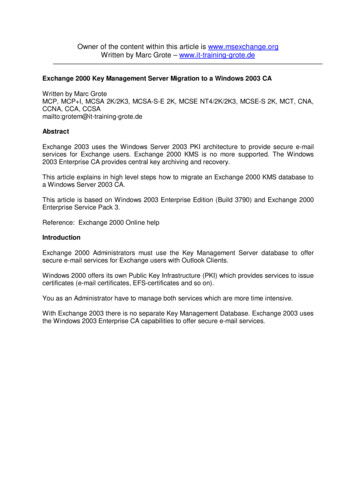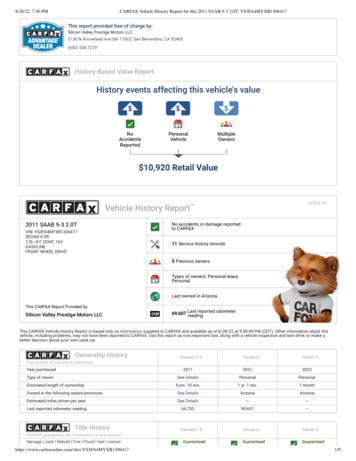
Transcription
Owner of the content within this article is www.msexchange.orgWritten by Marc Grote – www.it-training-grote.deExchange 2000 Key Management Server Migration to a Windows 2003 CAWritten by Marc GroteMCP, MCP I, MCSA 2K/2K3, MCSA-S-E 2K, MCSE NT4/2K/2K3, MCSE-S 2K, MCT, CNA,CCNA, CCA, ange 2003 uses the Windows Server 2003 PKI architecture to provide secure e-mailservices for Exchange users. Exchange 2000 KMS is no more supported. The Windows2003 Enterprise CA provides central key archiving and recovery.This article explains in high level steps how to migrate an Exchange 2000 KMS database toa Windows Server 2003 CA.This article is based on Windows 2003 Enterprise Edition (Build 3790) and Exchange 2000Enterprise Service Pack 3.Reference: Exchange 2000 Online helpIntroductionExchange 2000 Administrators must use the Key Management Server database to offersecure e-mail services for Exchange users with Outlook Clients.Windows 2000 offers its own Public Key Infrastructure (PKI) which provides services to issuecertificates (e-mail certificates, EFS-certificates and so on).You as an Administrator have to manage both services which are more time intensive.With Exchange 2003 there is no separate Key Management Database. Exchange 2003 usesthe Windows 2003 Enterprise CA capabilities to offer secure e-mail services.
Export of the Exchange 2000 KMS databaseBefore we export the KMS database we have to import a certificate from the Windows Server2003 CA which will be used to encrypt the exported KMS database. The steps to export acertificate from a Windows 2003 CA and to import this certificate into the certificate store ofthe Exchange Server are not part of this article.To start the export - Start Exchange System Manager and go to “Advanced Security”– KeyManager and select “All Tasks”– “Export Users”Figure 1: Export the KMS users in Exchange 2000 System ManagerBrowse the path to the exported Windows 2003 CA certificate. This certificate is used toencrypt the exported KMS database.Figure 2: Specify the exported Windows Server 2003 certificate
For security reasons enter the first eight characters from the thumbprint from the Windows2003 CA certificate.Figure 3: Enter the first eight characters of the thumbprintSpecify the name of the file for the exported KMS database. The default path is\EXCHSRVR\KMSDATAFigure 4: Enter the name of the export fileSelect the users to export from the KMS databaseFigure 5: Export the KMS users in Exchange 2000 System Manager
Congratulation: You have successfully exported the selected users.Figure 6: See the process of exporting the usersImport of the exported KMS database from KMS to Windows 2003 CABefore we can import the KMS database into the Windows 2003 CA store, we must enablethe Windows 2003 CA to archive private keys. To do this we have to issue a Key RecoveryAgent certificate for the account used to migrate the KMS database and to enable keyarchiving under “Recovery Agents”in the Certificate Authority SnapIn.The high level steps to this are:? Issue a “Key Recovery Agent”certificate Template (Start – All Programs Administrative Tools – Certification Authority – Certificate Templates – New –“Certificate template to issue”)? Create a custom MMC – and add the Certificate SnapIn for the User Account that willmigrate the KMS database? Specify the Key Recovery Agent certificate under the properties of the CertificateAuthority under “Recovery Agents”.Enable the CA for foreign key importBefore we can import the KMS database into the certificate store of the Windows 2003 CAwe have to allow the import of foreign certificates.Figure 7: Enable the CA to import foreign certificates
Now we have to import the exported KMS database with CERTUTIL:Figure 8: Import the exported KMS databaseSelect the certificate which we have used toexport the KMS databaseFigure 9: Select the certificate to encrypt the databaseImport the KMS database into the Windows 2003 CA with CERTUTILFigure 10: Import the KMS databaseKey recoveryRun the Tool KRT.EXE from the Windows Server 2003 Resource Kit to perform a GUIrecover of the selected certificate. You have to specify the serial number of the certificate inthe Value field to recover the certificate. Next click “Recover”to recover the certificate
Figure 11: The Key Recovery Tool (KRT)Choose the path to save the file and select a password to protect the recovered .PFX file.The Prefix .PFX shows that the private key is included in this file.Figure 12: Specify the path to the .PFX fileCongratulation. You have successfully recovered the certificateFigure 13: Import the exported KMS databaseConclusionThe integration of the Key Management Services from Exchange 2000 into the Windows2003 Enterprise CA is the next logical step for the Exchange 2003 deployment. With thisconstellation you can use the full power of the Windows 2003 Enterprise CA.Related LinksMicrosoft Exchange 2003 Homepagehttp://www.microsoft.com/exchangeWindows 2003 Homepagehttp://www.microsoft.com/windows2003
Exchange 2000 Key Management Server Migration to a Windows 2003 CA Written by Marc Grote MCP, MCP I, MCSA 2K/2K3, MCSA-S-E 2K, MCSE NT4/2K/2K3, MCSE-S 2K, MCT, CNA, CCNA, CCA, CCSA mailto:grotem@it-training-grote.de Abstract Exchange 2003 uses the Windows Server 2003 PKI architecture to provide secure e-mail services for Exchange users.











